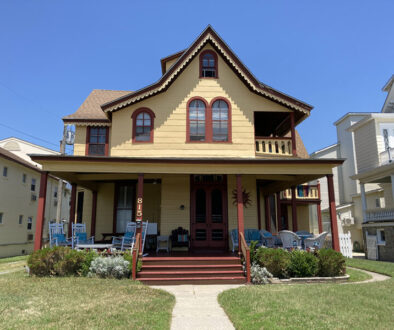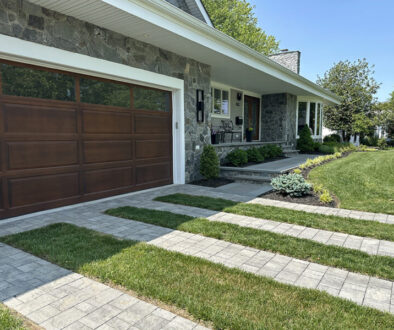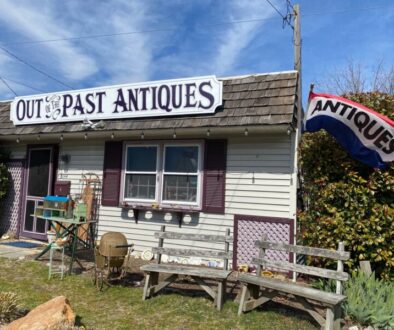Going “Down Jersey” to the Other Shore
Think of New Jersey as a flower that you must take time to really see. It’s not just beach towns—there’s a whole other shore hiding in plain sight. Some go “to the beach.” Others go “down the shore.” Then there are those who go to what has been referred to as “the other shore,” or “Down Jersey.” This is the bay shore of New Jersey. It’s just off course from the main traffic arteries clogged with travelers heading to beach towns during the summer months. The bay shore offers lessons in nature and history, unrivaled vistas, and the best sunsets in the state—if we make the time to see it.
Pack lunch, sunscreen, and bug spray. Gas up the car. Bring your binoculars and a camera. Artists, get ready to be inspired. Naturalists and birders, you’re in for a treat! Everyone else, be prepared to be delighted at what you will find on this easy-to-navigate one-day adventure. This trip has something for all ages and explores just the New Jersey side of Delaware Bay, which runs southeastward from the mouth of the Delaware River to the Atlantic Ocean.
The bay shore seems frozen in the distant past, but you don’t need a time machine to get there. Imagine traveling by boat down the Delaware River to Cape May, and you come to the part of your voyage where the river becomes the bay at Alloway Creek. Nature takes over. You would sail past mostly untouched natural wildlife management areas. Then signs of human life begin to appear on shore as you pass Fortescue, a town of approximately 400 residents. You’d pass more wildlife management areas before you approach Bivalve. We will begin here, but not by boat. From Cape May, we will travel by car up Delsea Drive (Route 47).
(Car game idea: We played “count the churches.” Early settlers established houses of worship, with denominations as diverse as the natural resources in this part of the world.)
Bivalve
“In every man’s heart, there is anchored a little schooner.”
– Henry Miller
The official t-shirt of Bivalve reads:
“Bivalve /’bi-valv/ noun
1. An aquatic mollusk that has a compressed body enclosed within a hinged shell
2. The home of the Bayshore Center at Bivalve and the A.J. Meerwald
3. A really cool place”
Bivalve is a really cool place—whether you like oysters or not! From Cape May, Bivalve is about 45 minutes by car. The Bayshore Center is located at the marina that is home to the famous schooner, the A.J. Meerwald, New Jersey’s official tall ship.
The Bayshore Center has a full events calendar, including their popular Second Fridays on the Bay and the New Jersey Oyster Festival, scheduled this year on October 21. Check njoysterfestival.com. The educational and cultural events offered throughout the year include a museum depicting the maritime and oyster shipping history of this location. Visit their website at bayshorecenter.org to plan your trip.
The A. J. Meerwald’s First Mate, Seth Matthews, was working on the sails and welcomed us aboard to check her out. She is a grand schooner! A vessel for education and cruises, she represents a time when life in these parts was tied tightly to the maritime tradition and the plentiful oyster harvests of days gone by.
The Bayshore Center’s Executive Director, Jessica Yorke, explained that the entire structure on the dock was once individual oyster companies. Signs of the companies hang in a row along the side of the museum, identifying each as “planters and shippers.” The companies would plant the oyster seeds and harvest them in the bay, then offload from barges to this spot where they would ship them all over the country via rail cars. In fact, there is still an old red rail car there, although today it has been fitted as restrooms for the museum. It’s the coolest bathroom ever for train enthusiasts.






According to Jessica, the real experience here is simply “taking a walk back in history to enjoy the museum, learning about the shellfish industry, the families who worked here, and just connecting the marine environment and the rich maritime history of the bay shores of New Jersey.” In late July and August, their café is open Thursday through Sunday. Jessica suggests “Bring your families here and enjoy a beverage by the bay, some oysters, and take a cruise on the schooner. There is a lot to learn about the lifestyle here. When you run out of things to do with your families, or are looking for something out of the ordinary, this is a hidden treasure you don’t want to miss.” They have a pub too, a “members only” establishment, but its very affordable membership directly benefits the Bayshore Center.
Bivalve, we will be back, but we must be on our way, heading south.
Our next stop will take us on a scenic drive to Maurice River Township.

Eastpoint Light
“I can think of no other edifice constructed by man as altruistic as a lighthouse. They were built only to serve.”
– George Bernard Shaw
New Jersey’s second-oldest lighthouse, built in 1849, the East Point Light has been through a lot in almost 175 years. Located at 10 Lighthouse Road in Maurice River Township, the lighthouse and its surroundings provide a true sense of being off the beaten path. The first image you see is a white house with a bright red roof, standing proud and regal among the natural backdrop of salt marshes and the bay. While exploring outside, we saw more pairs of cardinals than I’ve ever seen in one place. That alone was worth the drive.
The East Point Light has a light, and it is a house, but it’s not your typical tall, thin, conical-shaped structure. Its keepers’ families resided here in the past and it is set up as a hands-on museum for youngsters. It is as if you walked into a private home from the mid-1800s. Kids are welcome to climb the stairs to the upper level of the house and “light” it, receiving a certificate declaring them “Junior Lighthouse Keepers.” Climbing those stairs, we were taken by the expansive view of Delaware Bay—and a bald eagle flew past with perfect timing. We were told that’s not an uncommon sighting here.
Next to the house is a small building with a gift shop, carrying a variety of books, crafts, and more from local artisans. The President of Maurice River Historical Society, Nancy Patterson, provided us with a list of events throughout the year. You can find it at eastpointlight.com. They have Santa Claus in December and the Easter Bunny in April and participate in National Lighthouse Day on August 7. Many don’t realize that migrating monarchs appear here in abundance, which is why they hold a Butterfly Festival, this year on September 16th and 17th.
In the 1970s, as the story goes, some trespassers were at the property and a fire ensued, burning the building to a shell. However, the structure was refurbished to its original state in 1999. This area was also hit by Hurricane Sandy and brought new challenges and concerns for similar storms in the future.
The East Point Light was a pleasant surprise on this journey down Jersey, so much so that we will be back with some youngsters next time. Kids visit free; there’s a modest fee for adults.
It was time to continue to a quiet, natural environment.

Jake’s Landing
“The clearest way into the Universe is through a forest wilderness.”
– John Muir
From Delsea Drive, you’ll spot Jake’s Landing Road, easily identifiable via the white and red sign indicating that crabs are sold here, too. The drive starts as a ride through dense forest where you’ll see wild forsythia popping bright yellow blooms in spring among the thick greenery. This drive through the pines was longer than expected, but ends abruptly, opening into a dramatic, ethereal vista.
Skeletal remains of a pine forest rise from the salt marshes, with a backdrop of lush green forests, untouched by nature’s force. These shallow salt marshes are crucial to life at Delaware Bay. While these ghostly woods seem to be dying from encroaching salt water, there are more signs of life than most places on earth.
For birders and landscape photographers, it is ripe with possibility. Some call these the “ghost woods” due to sea level rising into lowland forests, producing a difficult survival habitat for these dying trees, but there is something beautiful and mysterious about this place. You’re in the middle of nowhere, and everywhere, with only the sounds of nature. A paved parking lot and a boat launch at the end invite explorers to quest further on the waterways here. We lingered a little longer than planned, to see and hear nothing but nature in this heavenly spot.
There is more to look at and learn about the other shore. Thus far, each place has been completely different than the one before it, and our next stop is no exception.

Crow Creek Farm
“Art is born of the observation and investigation of nature.”
– Marcus Tullius Cicero
An orange sign with a black crow beckoned us down the long driveway, where the forests and the fields meet the marsh on Crow Creek. While New Jersey is known as an agricultural state, farming everything from tomatoes and corn to peaches and flowers, art grows on this farm!
Crow Creek Farm is also known as The Sperlak Gallery and Sculpture Gardens. Imaginative sculptures line the driveway as you enter, and parking was plentiful next to the Amish-built barn that houses an art gallery featuring owner Stan Sperlak’s pastel paintings. Stan gave us a tour of the property that includes 24 acres of hiking path and over 150 pieces of art.
Sperlak recently wrote and produced a film for the Museum of Cape May County, 300 In the Middle, about the diverse history of Middle Township. Musical and educational events are hosted here as well. Check thesperlakgallery.com to learn more.
On to our next stop.

Reeds Beach
“I wanted to know the name of every stone and flower and insect and bird and beast. I wanted to know where it got its color, where it got its life – but there was no one to tell me.”
– George Washington Carver
We passed a couple of wineries before spotting the sign leading to Reeds Beach. We observed people surf fishing, and a few hikers on the rustic trail to the beach. An enormous cloud of white birds welcomed us, moving together from shore to land with a loud chatter along the coast where Bidwell Creek meets the bay. The Reed family still lives in the area, including Tom Reed, a local expert on birding and fifth-generation lifelong resident. Educated at Rutgers University School of Environmental and Biological Sciences, Tom earned his degree in Environmental Planning & Policy, and now works as a Migration Count Coordinator at Cape May Bird Observatory. He identified this flock as Snow Geese.
Tom leads the long-term monitoring research project for the bird observatory. “What I like about Reeds Beach most is the drive from Delsea Drive to the bay,” he said. “You travel through most of the major habitat types on the peninsula, from forests to the upland edge, to salt marsh to beaches, and to this huge bay.” It was his ancestors who cleared the path from Delsea Drive to the bay, creating Reeds Beach Road. Tom said his family always had a connection to this land through farming, fishing, trapping, and boat captaining. “The magic in this part of New Jersey is that there is just this peninsula, a little strip of sand, with such varied habitats and microhabitats that ‘Down Jersey’ exemplifies more than anywhere else.” He explained many of the roads are named after families who settled here. “You can still see some of the old fence property lines in the salt marshes.” At the end of the Reeds Beach Road is a large rock at the water’s edge with words graffitied on it, “You have reached Reeds Beach. Now go away!”
“Since COVID things have changed,” Tom said. “You see more people where you didn’t see them before.” He made a point of the importance of respect for the habitats by exploring humans. He thought readers would be interested to know that the Nature Conservancy holds an annual Spring Festival with a focus on the Down Jersey region, with programs in Belleplain State Forest and Jake’s Landing.
The sun is sinking fast, but there is one more stop on this road less traveled.

Highs Beach
“Every sunset brings the promise of a new dawn.”
– Ralph Waldo Emerson
Originally called King Crab Landing, Highs Beach was once a thriving oyster settlement. The name King Crab Landing wasn’t about the “all you can eat” type of King Crabs. It’s about one of the most famous residents of Delaware Bay, the Horseshoe Crab. Highs Beach is known for one of the most impressive demonstrations of the springtime eruption of horseshoe crabs. Tom Reed reminded us to not touch the crabs unless you are taking part in an environmentally friendly effort to gently flip overturned crabs to right them, aiding in their survival.

We quickly realized that Highs Beach only has three parking spots because they really don’t want crowds wandering around this fragile yet rugged wildlife habitat. Places like this are important reminders of how conscious we must be around the natural world.
Nature told us when it was time to end our excursion as we watched one of the famous Delaware Bay Sunsets from Highs Beach. “Home of the Best Sunsets” is not just a slogan. It’s true.
Beyond this point, the road is more of a beaten path to more densely settled Bayshore towns: Villas, Town Bank, North Cape May and finally to the Cape May-Lewes Ferry. Take a short road trip back in time to the other side of the peninsula and experience the history, natural wonders and the culture that remains (mostly) untouched, from a long ago past.
And P.S. We lost count after the 17th church!



